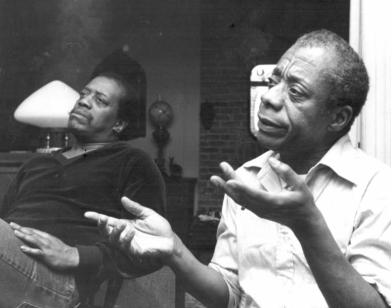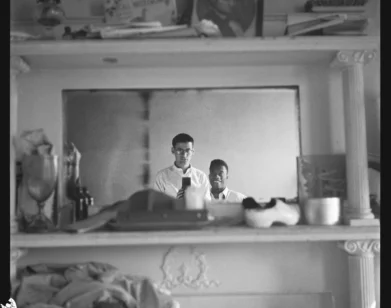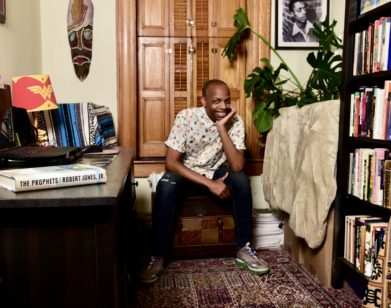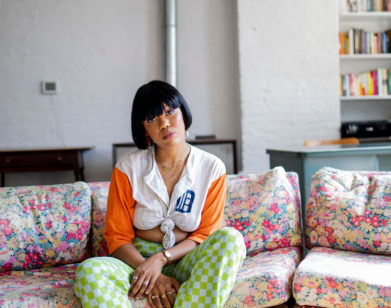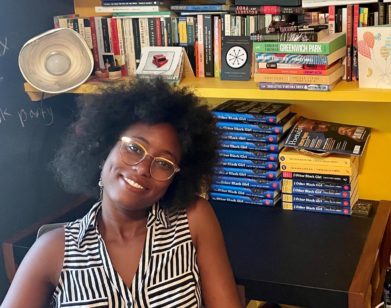GOOD ART FRIENDS
Lorna Simpson and Glenn Ligon on Finding Meaning as You’re Making It
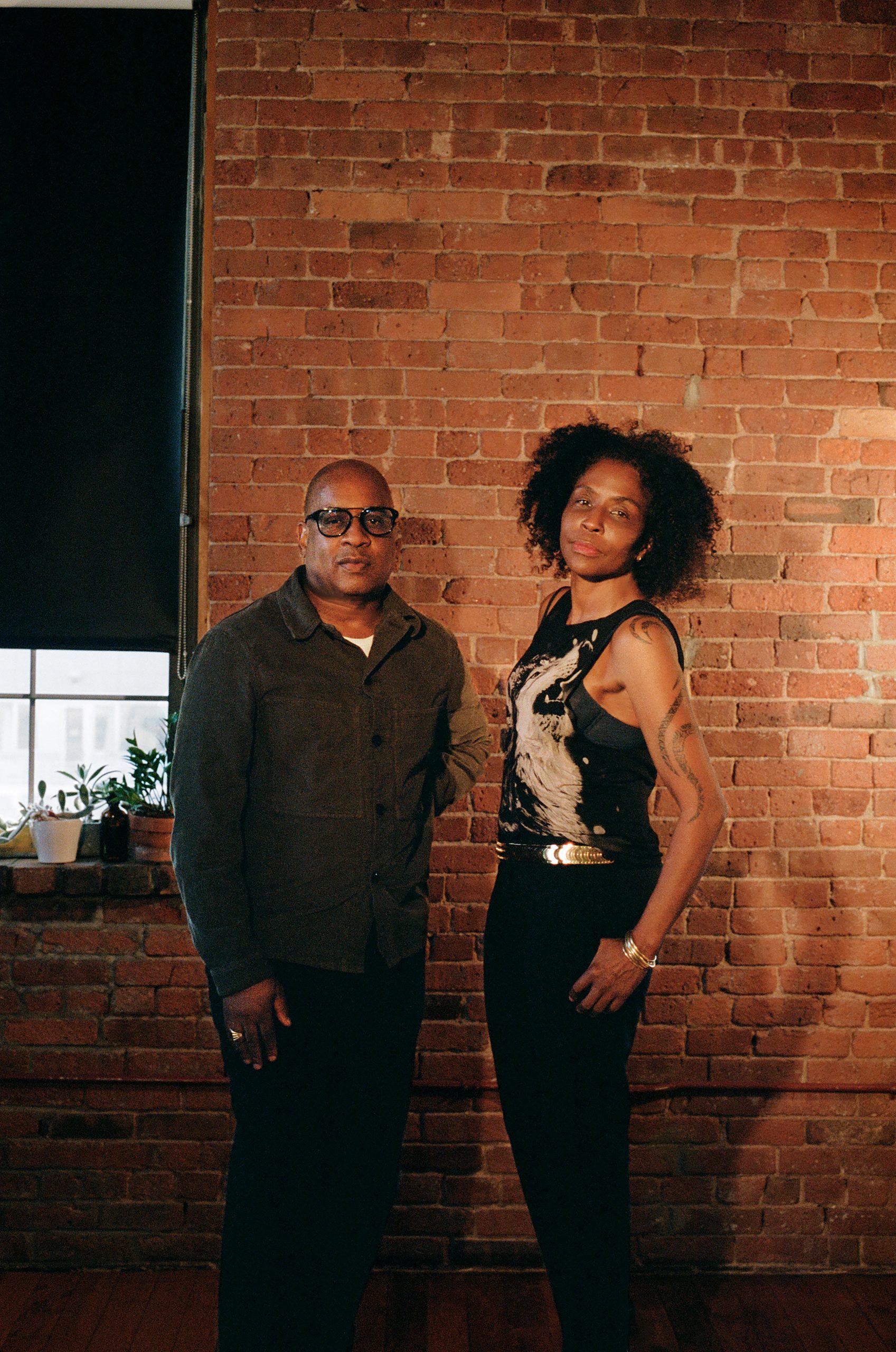
Lorna Simpson and Glenn Ligon were both born in New York City in 1960. If generational synchronicity means anything, it’s telling that both rose to prominence in the late 1980s and early ’90s, venturing from painting to socio-conceptual pursuits in photography, found imagery, sculpture, and text. They each managed, in their own style, to create provocative work that challenged the reigning notions of beauty and the Black body, and expand the conversation on what art can and must represent. Flash forward to 2021. Simpson and Ligon are towering art-world figures, as well as friends. Serendipitously, both artists are represented by Hauser & Wirth gallery, where each recently exhibited new work. Simpson, at the Los Angeles branch, showed an interactive sound sculpture, paintings, screen prints, video, and collages (wrenched from old issues of Jet and Ebony). Ligon, in the New York gallery, recently unveiled a James Baldwin text-painting, along with his signature neon works and “Debris Field” paintings.
Neither Simpson nor Ligon could be 100-percent certain where or how they first met. Ligon vaguely recalls a first run-in sometime in the mid-’80s, while Simpson remembers meeting at the Whitney Museum in the early ’90s. A short while ago, they spoke by phone about post-pandemic art practices and how to find meaning as you’re making it.
———
LORNA SIMPSON: You have a very significant exhibition opening this winter, and I know it’s taken a lot of preparation. How has this journey of making work been different from other times?
GLENN LIGON: It’s an odd time to be doing a big show like this, and even odder that it was originally scheduled to open right around the presidential election. As you know, in the ongoing wake of COVID-19, with my studio being shut down, it’s good that it was postponed. It gave me more time to think about the work. I also moved into a larger studio during this period, which helped. One of the paintings uses the entire text to “Stranger in the Village,” which is a Baldwin essay I’ve been engaged with for more than 20 years. But I’ve never done paintings using the entire text before. So this sudden increase in studio size plus extra time really made a difference.
SIMPSON: What immediately came to my mind was Okwui [Enwezor, the late art curator] saying, “Oh, Glenn, now it is a history painting.”
LIGON: Yes, it is a history painting. That’s exactly right. We know that Okwui, as a curator, was quite panoramic. He wanted to come big and come inclusive and come with the history. Certainly, Okwui was in the back of my mind when I was making the first of these paintings. He always pushed us as artists to be all we could be. For this upcoming show I’m using the entire gallery. There’s also going to be a big new neon.
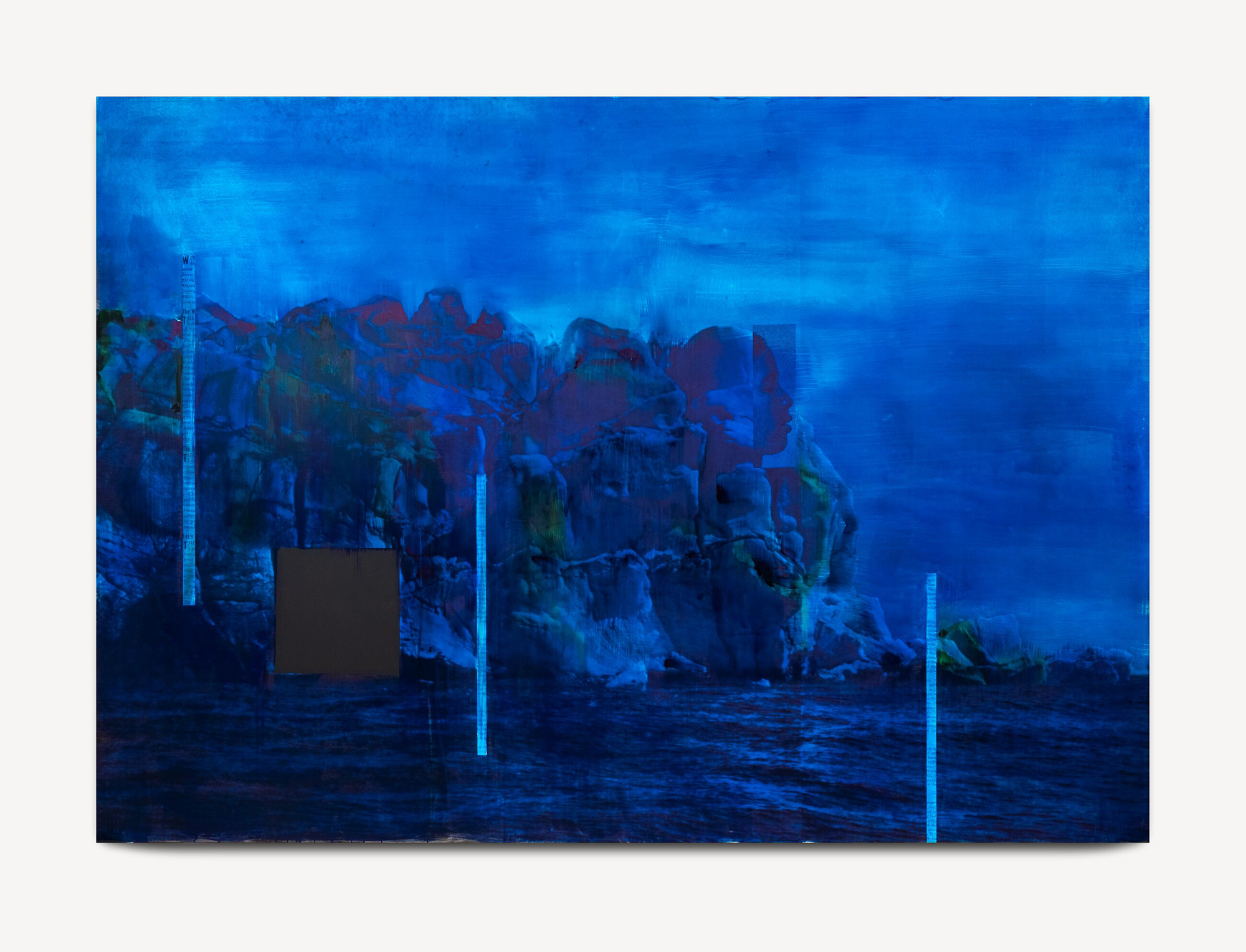
Lorna Simpson, “Reoccurring,” 2021.
SIMPSON: I could see the “Stranger in the Village” painting taking up a floor all its own. There is an accessibility in your work that has a life beyond you and beyond a single gallery.
LIGON: I’m also showing that painting by itself in Zurich. You must feel this, too. When you’re engaging a figure like Baldwin, you want to do something that is—
SIMPSON: As bold as they are.
LIGON: Exactly. To be as bold as the thinking that inspired the work to begin with. That was the impetus. Baldwin, like Okwui, was panoramic in his thinking. He’s in this little Swiss village in the ’50s up in the mountains. He was, for many of the villagers, the only Black person they’d ever seen, but he’s thinking about the Civil Rights Movement. He’s thinking about Europe’s relationship to Africa and colonialism. All of these things are coursing through this modest essay.
SIMPSON: That modest essay has had a huge impact even a century later. It’s interesting that you’re showing that painting in Switzerland, which returns that work to that space, given the specter of what’s going on in the United States right now.
LIGON: Europeans often imagine that racism in the United States is a category by itself. That they don’t have these problems in Europe. Recent history has shown that to be a lie, but the fiction of a color-blind society is still there. And yes, it’s also an opportunity to show these paintings in the space where Baldwin generated the essay. What has working been like for you during the pandemic and the aftermath of the election?
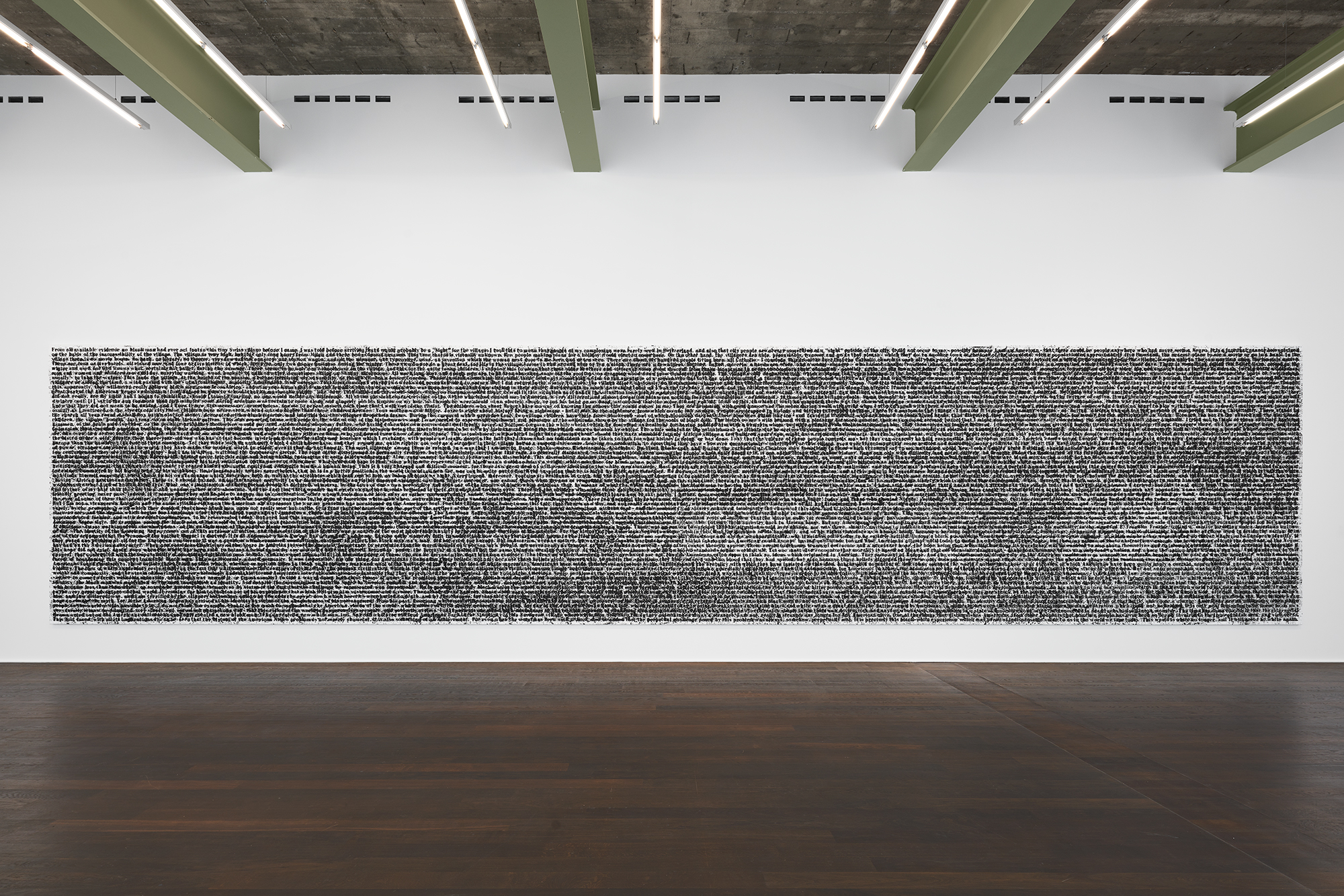
Glenn Ligon, “Stranger (Full Text) #1,” 2020–2021.
SIMPSON: There have been hard moments. In terms of work, it’s taken some juggling. I had a show prepared for Hong Kong at the beginning of the pandemic, and I went back into my studio in New York after many months away, and it all felt very distant. I had to ask myself, how do I reenter my own work? My head was in a completely different place. So I looked at the paintings I had done and retooled them, sent them back to silk screeners, and eliminated some completely. I felt like I needed to reorient myself in the work in order to move forward. It was a slow process because I felt like I was working blind. But when you’re in the studio again and living with your work and seeing your own language come to life again, you think, “Oh, that’s what that looks like. I’ve been there” And that feels good.
LIGON: I think we’re alike in the sense that we both find the meaning in the work as we’re making it. You can be confident about your work, but also confident about the process, and know that if you keep working, you’ll figure out what the work is doing. It may not happen immediately. Sometimes, two or three years later, I’ll be like, “Oh, that’s what that painting cycle was about.” Or the possibilities for it will suddenly unfold on their own.
SIMPSON: That’s what’s really interesting about having conversations with other artists and writers. They can point out threads running through your work that you might not have considered. Suddenly you think, “Oh my god, I see that.” And you’re right, sometimes it takes a year or so to see it.
LIGON: But don’t you also find it can be productive for things to remain a bit opaque and unconscious while you’re working on a piece?
SIMPSON: In the studio, yes. For me, there can be a danger in overthinking themes or overthinking a directive. It’s hard to have those conversations in the midst of working because I don’t want to infuse a literal reading onto the work. I want to keep that amorphousness going, where I flow without trying to over-contextualize. Over-contextualizing can inhibit free thinking.
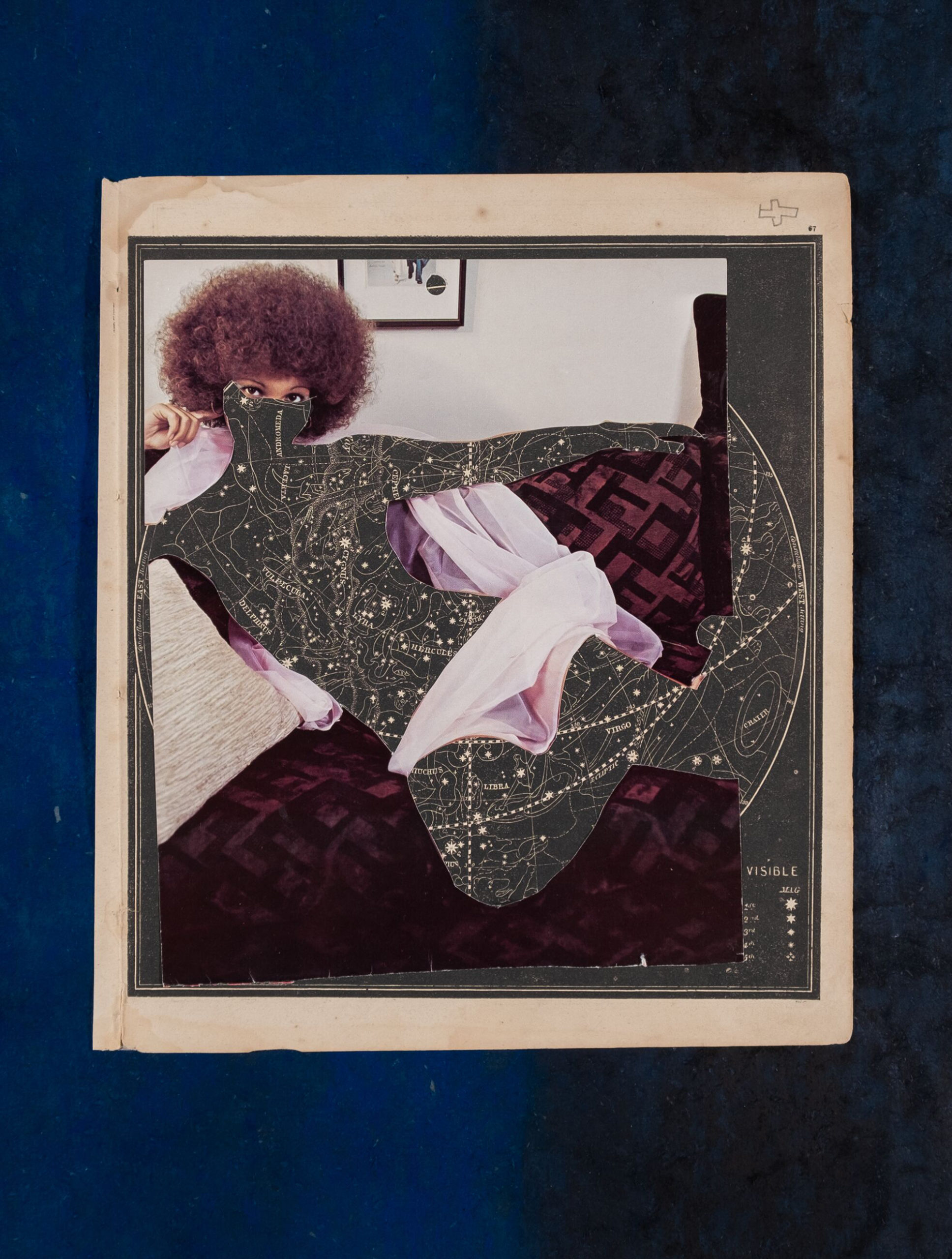
Lorna Simpson, “Everrrything,” 2021.
LIGON: Sometimes it’s just a matter of somebody’s voice being too strong in your head. Okwui had a very strong voice.
SIMPSON: What’s incredible is how his words stick with you. It was a great gift of his, sharing how he thought through works, or how his thinking process moved.
LIGON: That’s what artists do: put together all these bits and pieces in the studio and react to what’s going on around them, in their private environment or in the world, and synthesize all of that consciously or unconsciously into the work. The work is being made in the world. It’s not like we’re up in towers making stuff. And you’re right about learning from other artists. I had a funny experience going to Julie Mehretu’s show at the Whitney. There’s a film by Tacita Dean in Julie’s studio, of her making a cycle of paintings. It’s just scenes of Julie making the work, assistants running around, Julie looking at paintings on the computer, moving things around, Julie sitting in a chair framing a section of a work with her hands and asking herself, “Does this little piece work?” It was so instructive to me. You have ideas because you’re working with assistants and they work on the paintings based on your ideas, but then you go in and you improvise on them. Then, you do that old painter thing where it’s like, “Does this section work?”
SIMPSON: “Am I about to fuck it up? Should I stop?”
LIGON: Yeah, it was instructive because I’d never really worked with a computer while working on a painting. Suddenly, I was like, “Instead of just taking this big old stencil and making a mark on this canvas, why don’t I take a picture of the canvas and put the big old marker on the painting digitally and see if it works?” You would think after 61 years I would’ve come to that conclusion sooner. It never occurred to me until I saw Julie in that film. So what are these new projects you’ve been working on?
SIMPSON: A photo booth piece, a bunch of paintings, a couple of sculptures, a video collage. There’s an outdoor courtyard piece that consists of bluestone from the New York tristate area with obsidian singing bowls on top. When I was thinking what I should do for this next show, I was sitting with my daughter, Zora, on the couch, and I had some reclaimed paving stones stacked up in the backyard because we were putting in a new patio. If COVID has told me anything, it’s that it’s important to have an outdoor space where you can eat and gather. Zora and I got to talking about the stones, and I was saying how amazing it would be to have these foreign-looking stones in the show in California. It turned out really beautifully, and it’s participatory. If you visit it, you can play the singing bowls.
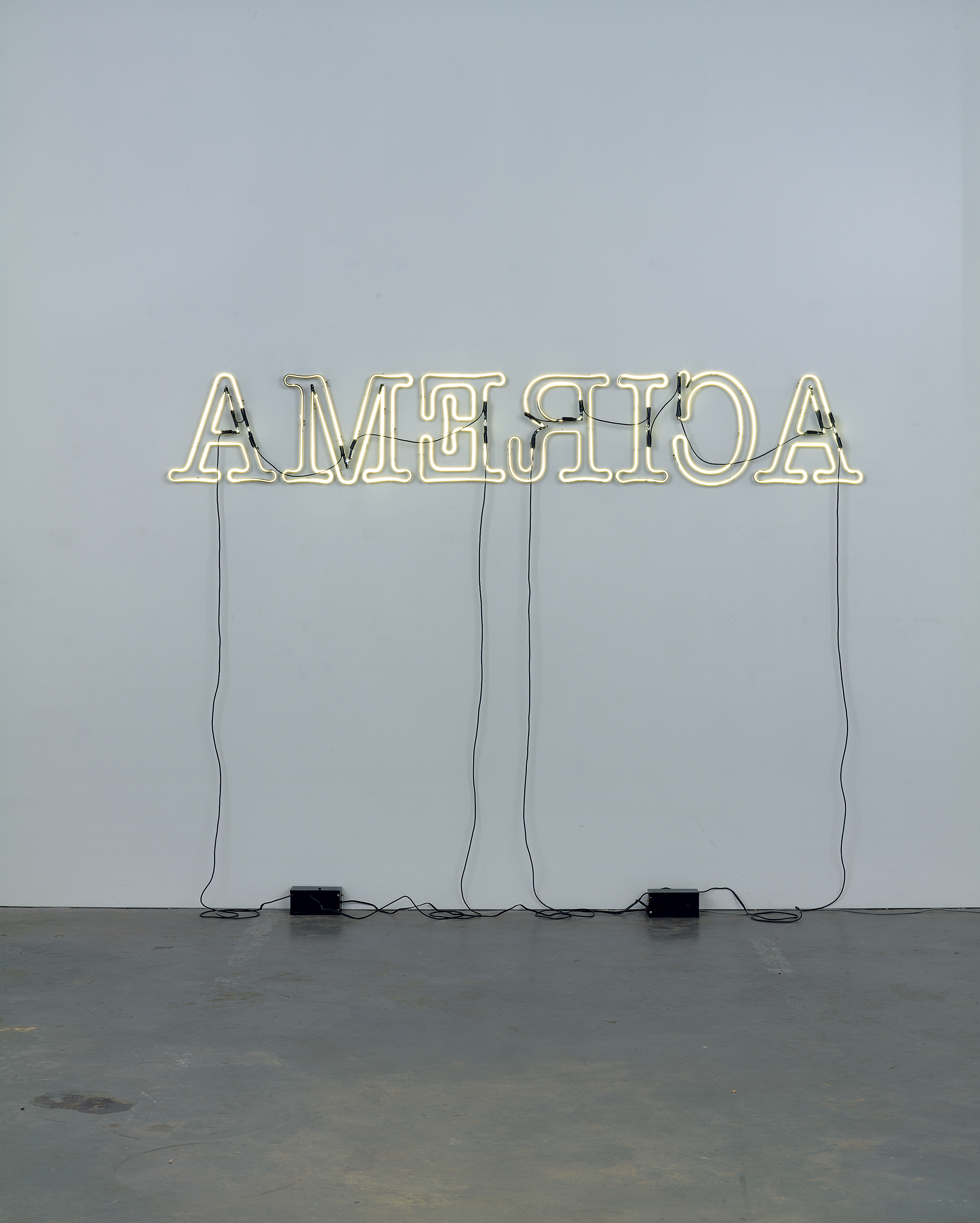
Glenn Ligon, “Rückenfigur,” 2009.
LIGON: There’s so little opportunity in the space of gallery exhibitions for a participatory gesture. Mostly, it’s, “Don’t touch.” I love this gesture of, “Yes, you can touch it.” I know you’re in L.A. right now. Do you have a studio out there?
SIMPSON: I’ve been here a lot this year, but I decided I don’t need a studio out here. I feel that my work life in New York is so well set up and ready for me that if I need to work, I go there.
LIGON: Have you been writing a lot?
SIMPSON: Part of my daily activity has become writing poetry or stories. It was prompted by conversations with Robin Coste Lewis, poet laureate of Los Angeles. Of course, writing and language has always been part of the work, but it was a really beautiful return to it in a different way. There are so many different aspects to what I do, and lately working visually was suspended for a bit and writing came in as an activity.
LIGON: I remember giving a talk once where I said my schtick, “I’m a painter.” The person sponsoring the talk said, “I make visual art. I write. I teach. I do performances. All of it’s my practice.” I was like, “Oh, snap.” But really, why separate out these various creative endeavors from one another? They’re all part of your practice.
SIMPSON: Yes, they all fuel one another.
———
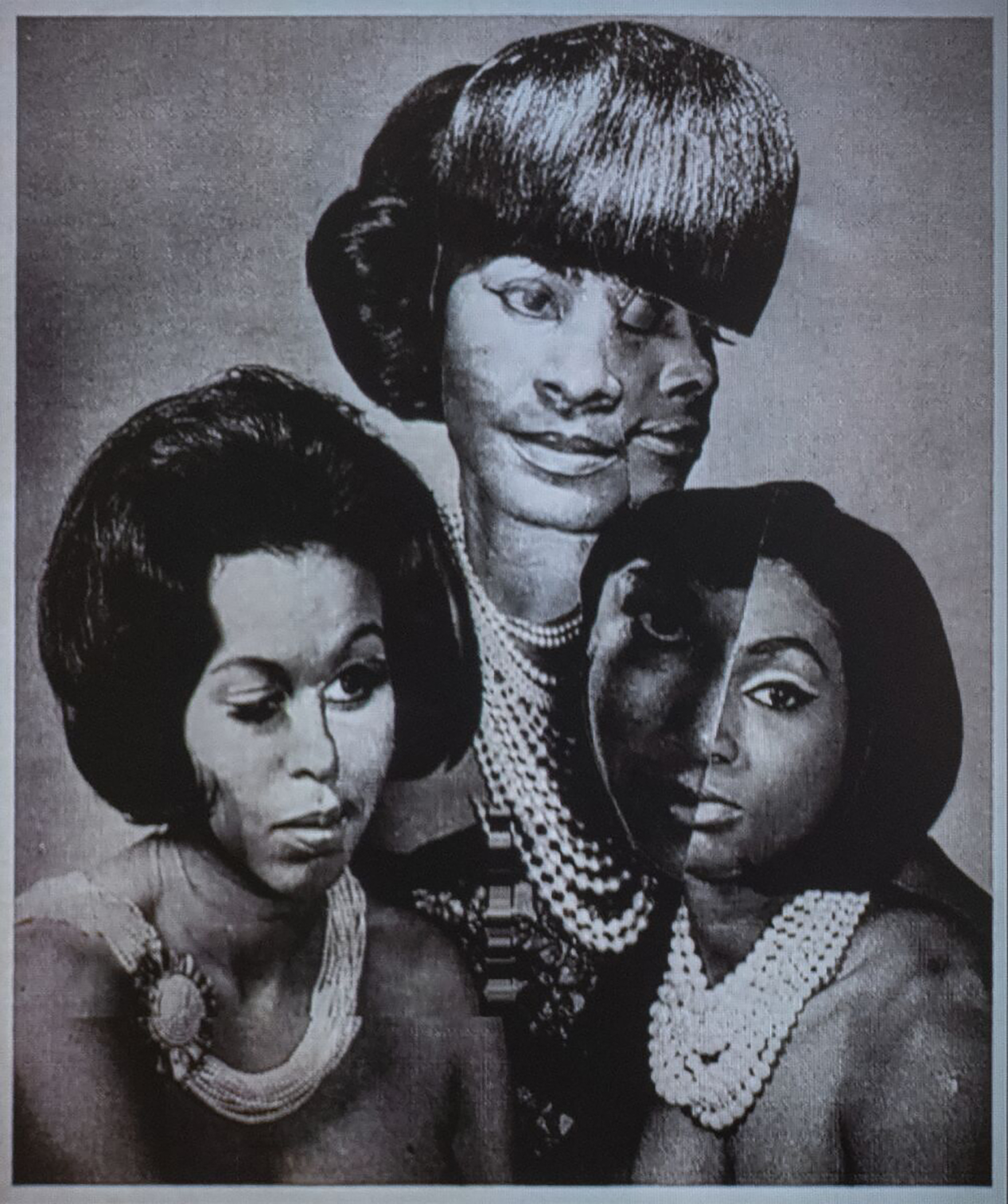
Lorna Simpson, “Walk with Me,” 2020.
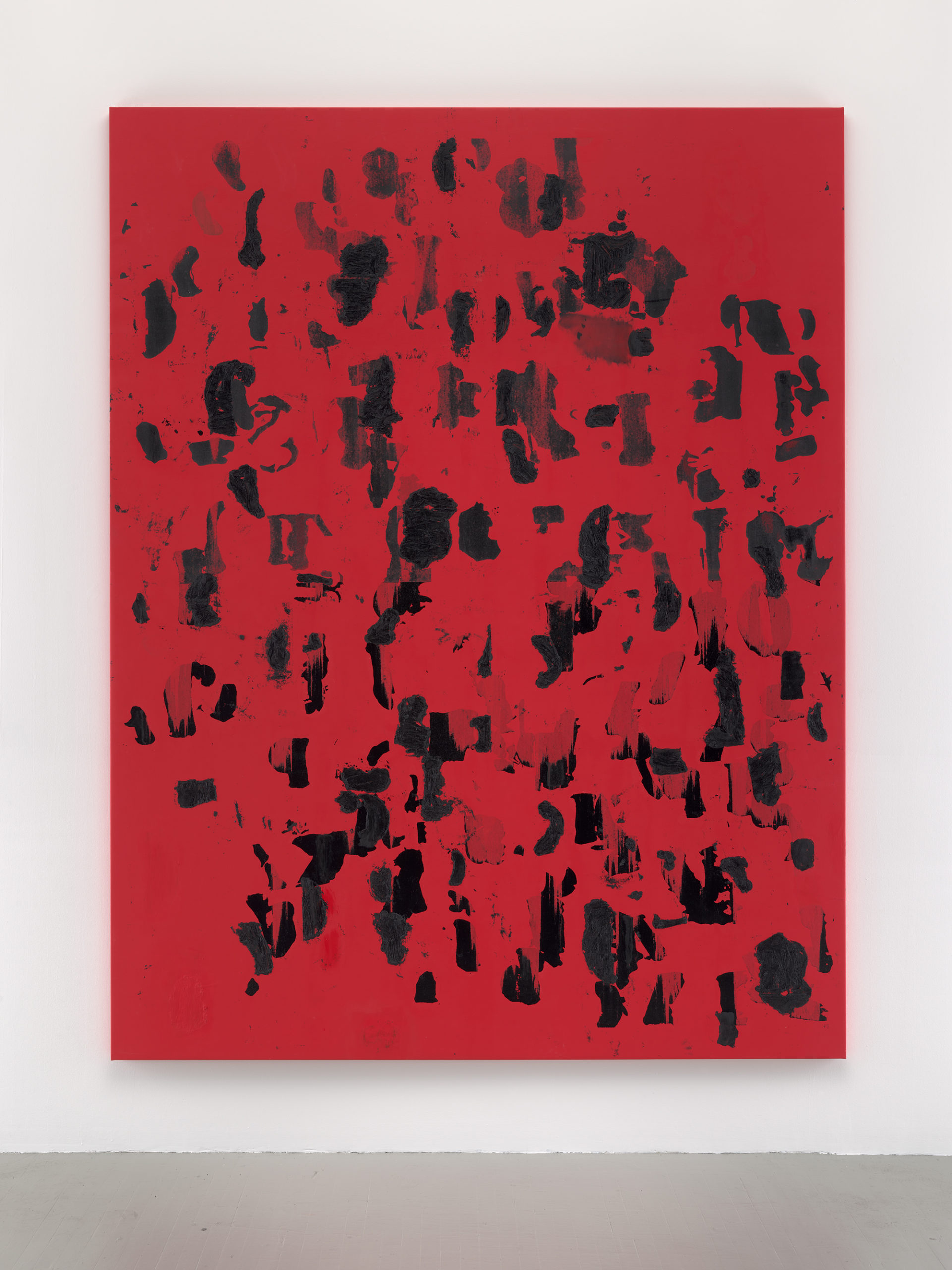
Glenn Ligon, “Debris Field (Red) #18,” 2020–2021.
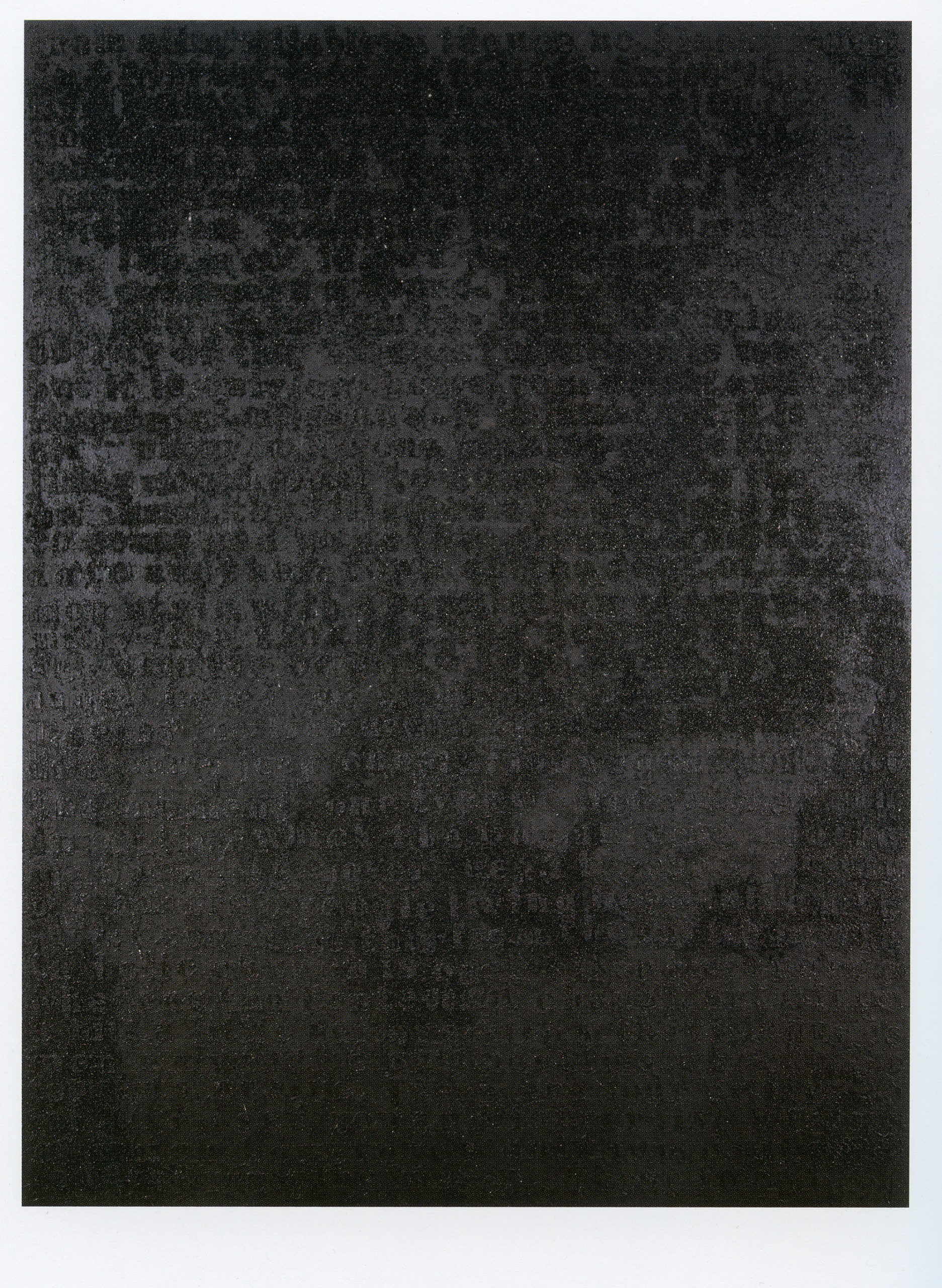
Glenn Ligon, “Stranger #21,” 2005.
———
Production: Perris Cavalier at The Morrison Group.
———
© Lorna Simpson, courtesy the artist and Hauser & Wirth, Los Angeles
© Glenn Ligon; courtesy the artist, Hauser & Wirth, New York, Regen Projects, Los Angeles, Thomas Dane, London, and Chantal Crousel, Paris


